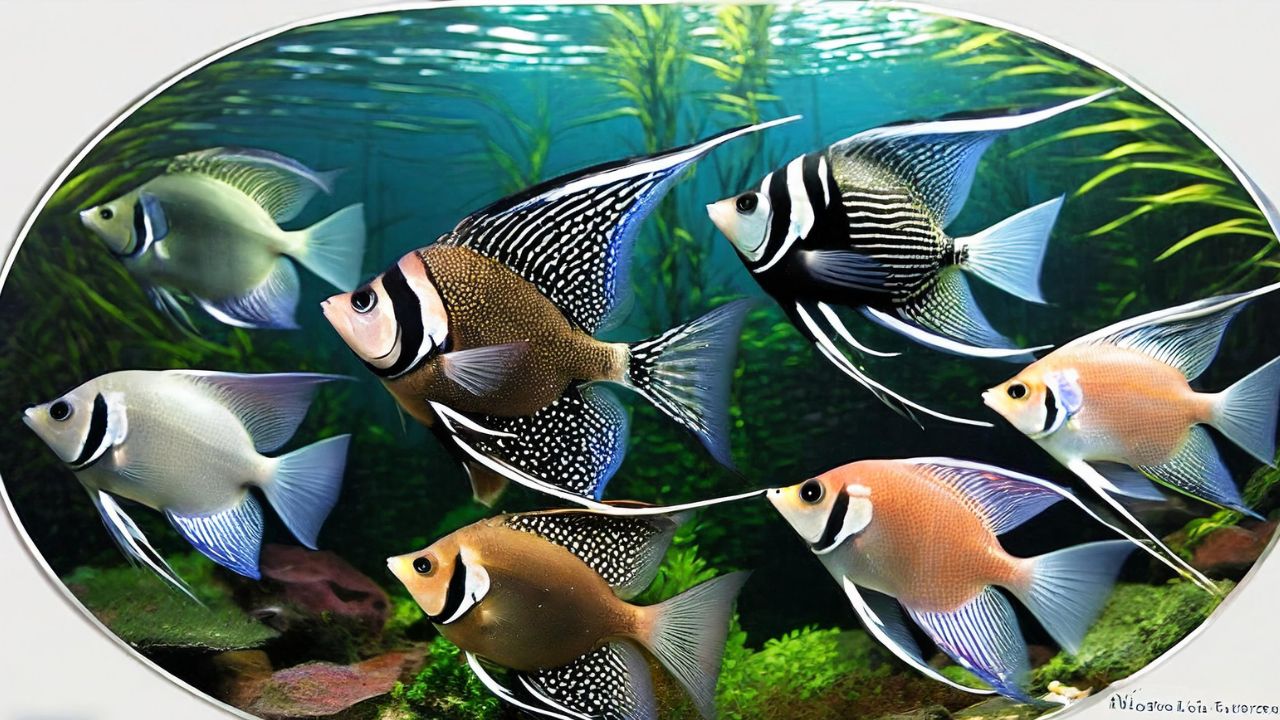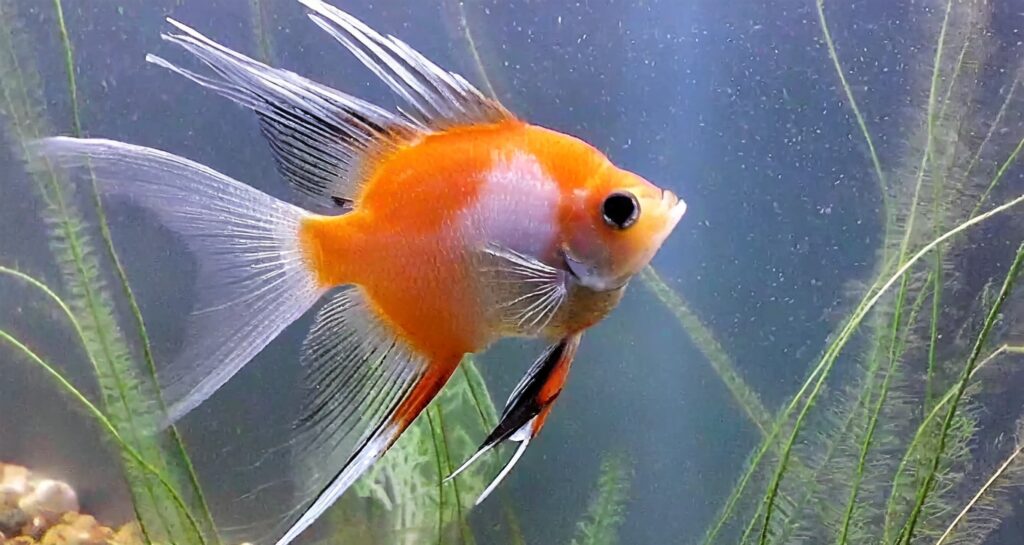
Angelfish are some of the most popular and beautiful aquarium fish kept by hobbyists around the world. But with over 20 varieties spanning multiple species, it can get confusing determining the best types of angelfish for your tank. This article breaks down the most popular freshwater and saltwater angelfish, covering key differences, ideal tank conditions, compatibility, care tips, breeding, and more to help you make the best choice.
What is an Angelfish?
Before jumping into the topic ” Types of Angelfish”, It is necessary to take an overview of the fish.
Angelfish belong to the Cichlidae family and originate from South America. They are named for their wing-like fins that span out to the sides like an angel’s.
In the wild, these fish inhabit slow-moving rivers, flooded forests, or coral reefs. But in captivity, their elegant appearance makes them a mainstay choice for community tanks and peaceful displays. Their hardiness, moderate size, and intriguing behaviors also make them widely enjoyed by aquarists of all experience levels.
Species Types
There are primarily three freshwater angelfish species Known in the aquarium market:
- Pterophyllum scalare – Common Angelfish.
- Pterophyllum altum – Altum Angelfish.
- Pterophyllum leopoldi – Leopold Angelfish.
The three angelfish species originate from the Amazon River basin in South America.
The most commonly available species in the aquarium trade is Pterophyllum scalare, which has been bred for generations and is quite hardy.
Pterophyllum altum, also known as the Altum angel, is less frequently seen but makes an interesting alternative for more advanced aquarists.
Finally, Pterophyllum leopoldi represents the rarest option as it is usually wild-caught. This makes it more challenging to acclimate to home aquariums, though its smaller size is better suited to typical tanks.
15 Common Types of Angelfish (Freshwater).
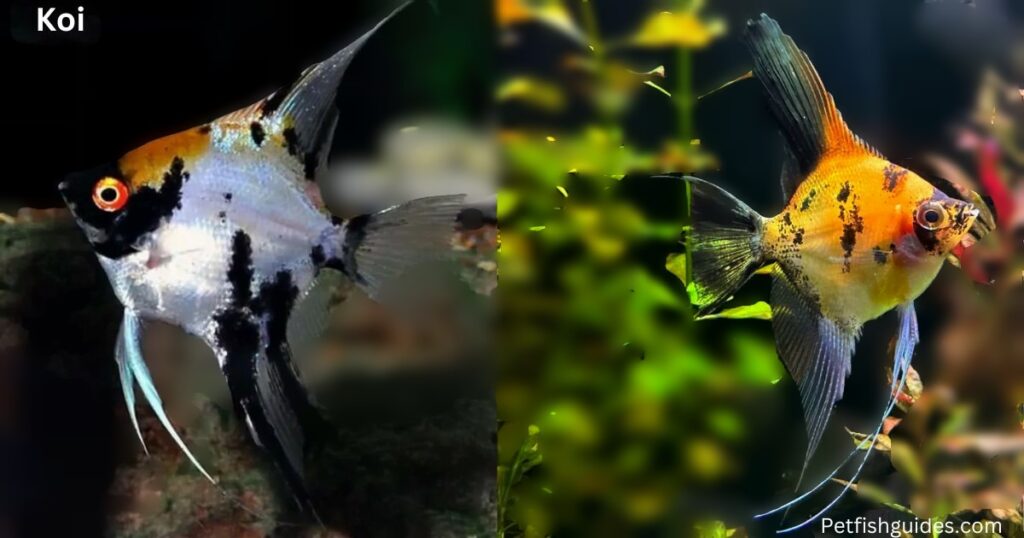
1. Koi Angelfish
- Species: Pterophyllum scalare
- Color: White, yellow, orange, black
- Size: Up to 7 inches long
The koi angelfish gets its name from the colorful markings reminiscent of koi fish. Its bright white body displays prominent blotches of red, black, and sometimes rich orange. No two koi angels have the same patterns. Each fish sports a unique canvas of vivid colors.
The intensity of the orange hues shifts with the fish’s moods. Brighter oranges appear when active and alert. Paler tones emerge when stressed. So the shifting shades act as a visual gauge of the koi angel’s general demeanor.
As they mature, the markings slowly evolve across the koi angel’s lifetime. So owners can observe how their fish’s one-of-a-kind palette transforms in the aquarium over many years. The visually striking and ever-changing patterns contribute to the koi angelfish’s popularity.
2. Zebra Angelfish
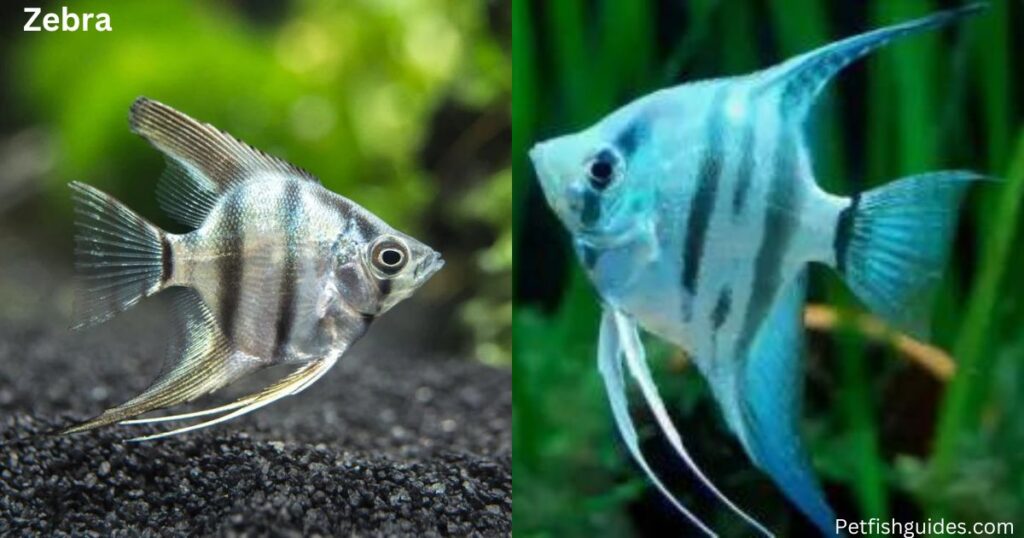
- Species: Pterophyllum scalare
- Color: Blue / White with Zebra pattern of vertical stripes
- Size: Up to 10 inches long.
Zebra angelfish have a striking appearance that explains their name. Their bodies feature broad black and silvery-white stripes, typically four to six in number, that run vertically along their length. The eye-catching color contrast between the bold stripes makes zebra angelfish a popular choice for home aquariums.
3. Albino Angelfish
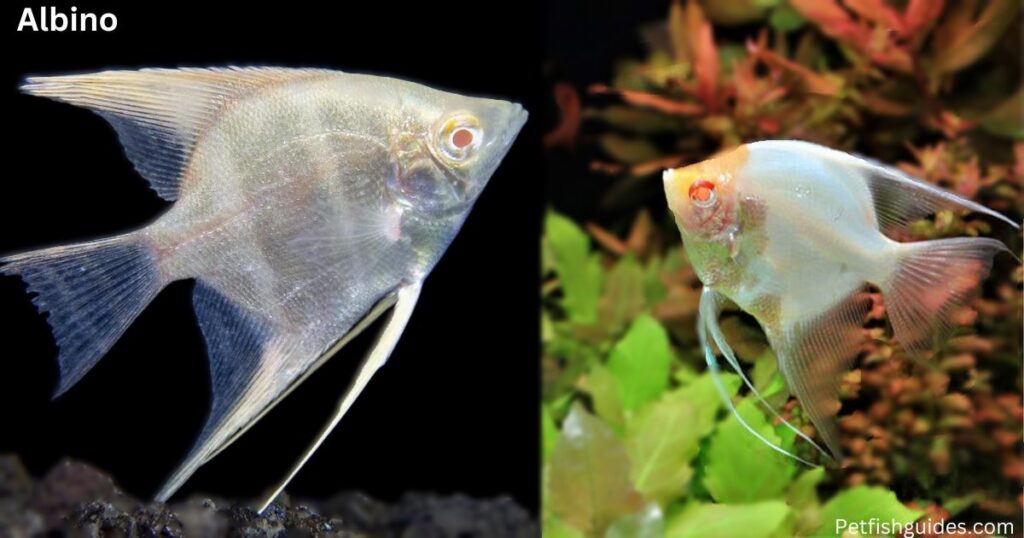
- Species: Pterophyllum scalare.
- Color: White.
- Size: Up to 6 inches long.
Unlike wild angelfish variants with dark stripes, albino angelfish have a pale pinkish-white hue and red eyes due to their genetics. Specifically, they carry recessive trait genes that inhibit melanin, the pigment responsible for darker tones. As a result, albino varieties completely lack the black coloration and bold patterns common among their wild counterparts.
While they stand out for their singular appearance, maintaining excellent water quality and care remains imperative for albino angelfish health. Their genetic makeup means they tend to be more sensitive to water changes and need consistency in their living conditions. Caring for these uniquely pigmented fish poses some challenges but the beauty of their ruby eyes and translucent fins is considered well worth the extra effort by enthusiasts.
4. Black Veil Angelfish
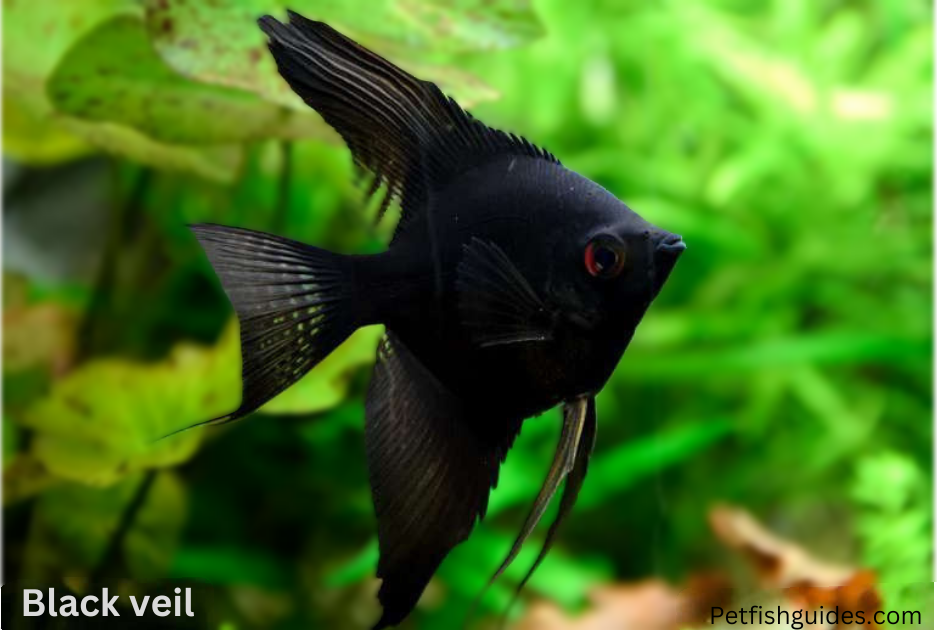
- Species: Pterophyllum scalare.
- Color: Black.
- Size: Up to 5-6 inches long
The Black veil angelfish displays a striking appearance with its rich, intense inky black hue extending across its entire body. Through selective breeding programs, the black veil variety has been developed to achieve an extremely dark pigmentation far beyond wild angelfish. Another signature feature is the graceful elongation of its dorsal and anal fins, which flow out prominently from the body like a dark bridal veil. The sustained fins ripple gently in the water, resembling delicate black lace floating elegantly behind the fish.
The combination of amplifying both the black color intensity and the flowing elongated fins gives the black veil morph a commanding yet beautiful presence underwater. Attaining such dark pigmentation and lacy trailing fins remains a rare achievement in angelfish breeding. As a result, the eye-catching balance of amplifying these specific traits makes the black veil variety a most coveted form among angelfish enthusiasts.
5. Marble Angelfish
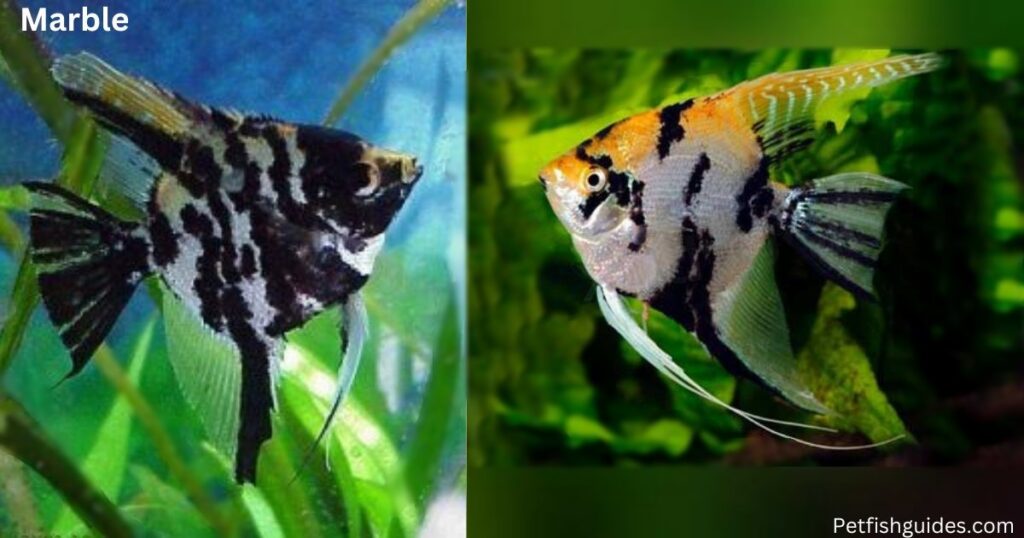
- Species: Pterophyllum scalare.
- Color: Black, White & Gold.
- Size: Up to 6 inches long
Marble angelfish feature mesmerizing abstract patterns in black, white, and rich golden orange, boldly splashed in marbled streaks or spotty splotches across their bodies and fins. No two marble varieties manifest the same markings. The uniquely stylized appearance stems from dedicated breeding programs focused specifically on enhancing the intensity, contrast, and dispersion of this color morph’s signature chaotic patterns. The randomly scattered yet visually balanced distribution of pigments results in a distinctive palette resembling a fluid abstract painting for each individual marble angelfish.
While chaotic in nature, the vivid collaborative blending of contrasting fiery orange, starry white speckles, and inky black marble strands creates visual harmony. This one-of-a-kind layered abstract style continues to drive marble angelfish popularity.
6. Blushing Angelfish
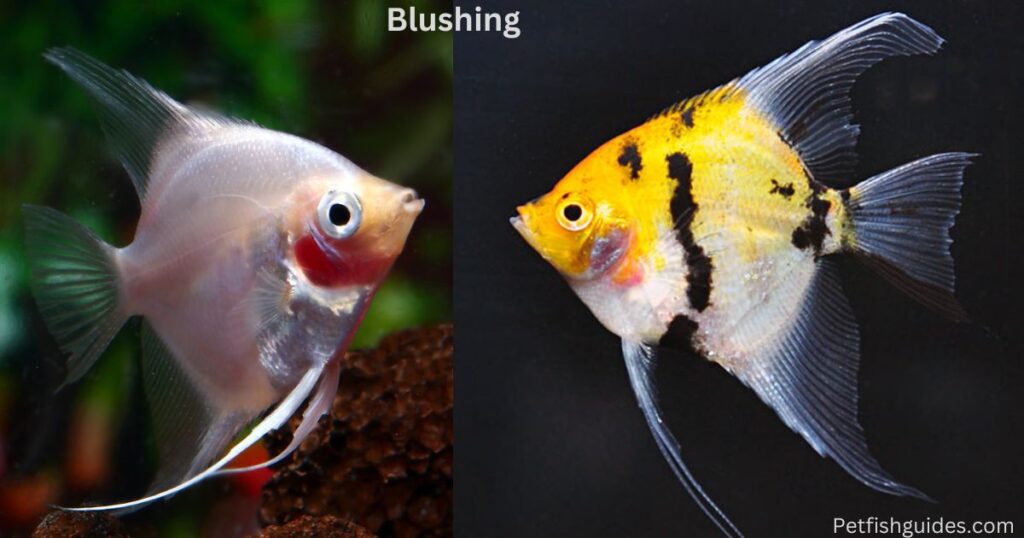
- Species: Pterophyllum scalare.
- Color: Silver / White with Red Chicks.
- Size: Up to 5-6 inches long
The name “Blushing angelfish” springs from the vibrant reddish-orange hues that vividly flush their cheeks, visible through translucent gill plates on an otherwise gleaming silver body. While their elegant silver shimmer dominates across the frame, the splashy orange gill flares burst brightly right below the dorsal fin.
In some varieties, graceful dark grey mottling may also emerge in delicate wisps, playing a subtle counterpoint across the sheen. It is this striking yet balanced interplay of a primarily lustrous canvas amplified by the bold colorful cheek accents that give blushing angels their charming glow. The fiery blush and understated slate mingling remain truly eye-catching and underscore why they are so aptly christened the “blushing” morph among angelfish breeds. Their beauty and distinct cheeky color flair help fuel their popularity for home aquariums.
7. Ghost Angelfish
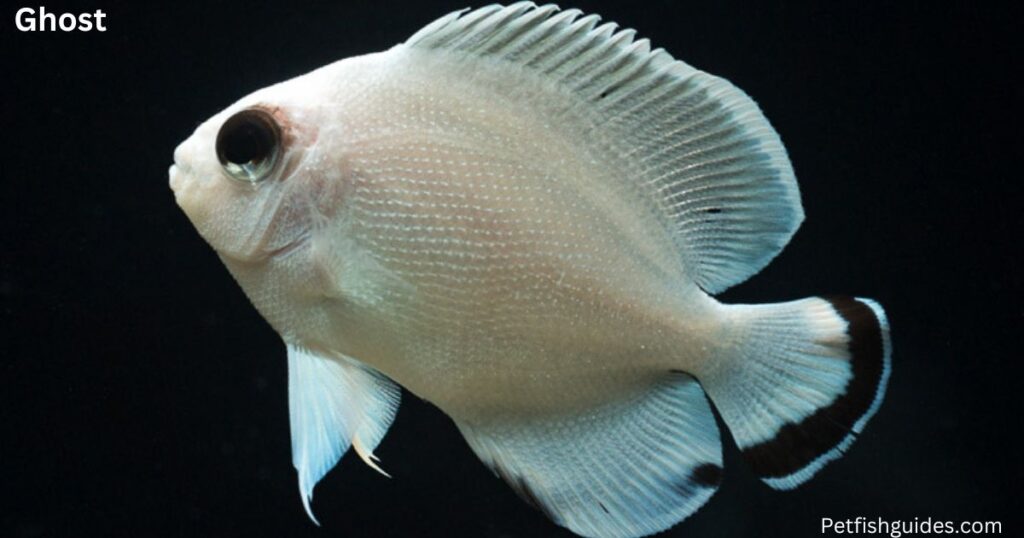
- Species: Pterophyllum scalare.
- Color: Variable.
- Size: Up to 7 inches long
The most common ghost angelfish seen have an undecorated grey color across their body. This plain solid grey appearance is why they are named “ghosts”. They live up looking like a grey phantom drifting in tanks.
Unlike many angelfish, ghosts lack clear stripes or other fish patterns as juveniles and adults. Their scaleless body shows only an uninterrupted grey hue. This single color makes them stand out for having no embellishments.
Sometimes when older, ghost angelfish can develop faint bands. But most keep their simple featureless grey shade their whole life. This absence of decorative stripes or spots is the key sign of the ghost variety. Their phantom-grey coloration hovering in the water explains why they earned the ghost name.
8. Silver Angelfish
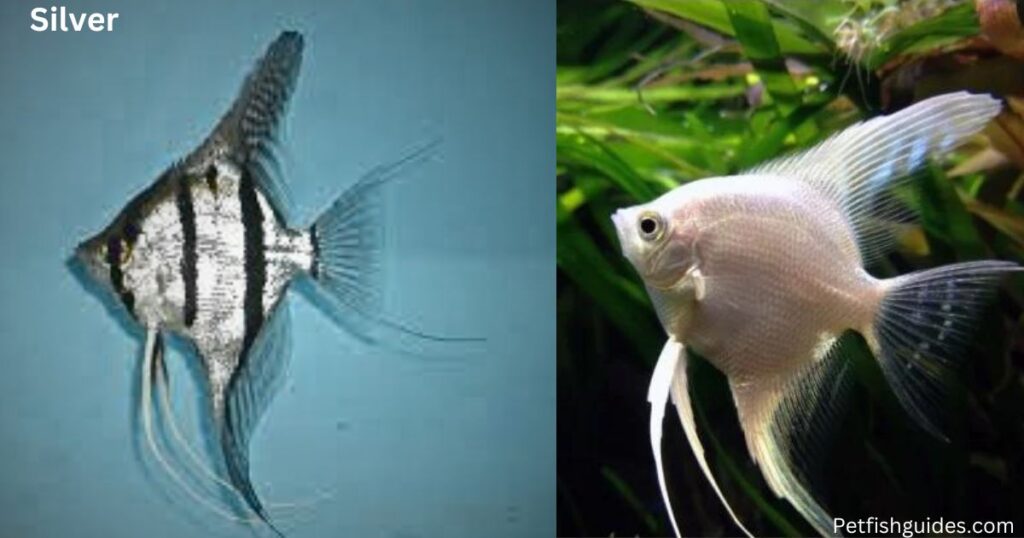
- Species: Pterophyllum scalare.
- Color: Silver / White with red eyes.
- Size: Up to 7 inches long
The silver angelfish variety shares great similarities to wild types. It displays the iconic appearance of three thick vertical black stripes traversing its shimmering white body. This classic barred pattern seen in natural angelfish makes the silver morph instantly recognizable.
Unlike more elaborate color varieties, the silver morph retains familiar and easy-to-care-for natural aesthetics. Its straightforward black and white color scheme reflects angelfish found in the wild. The natural classic look and comparatively easy maintenance for this common form keep the silver angelfish as one of the most popular choices for aquarists.
9. Gold Angelfish
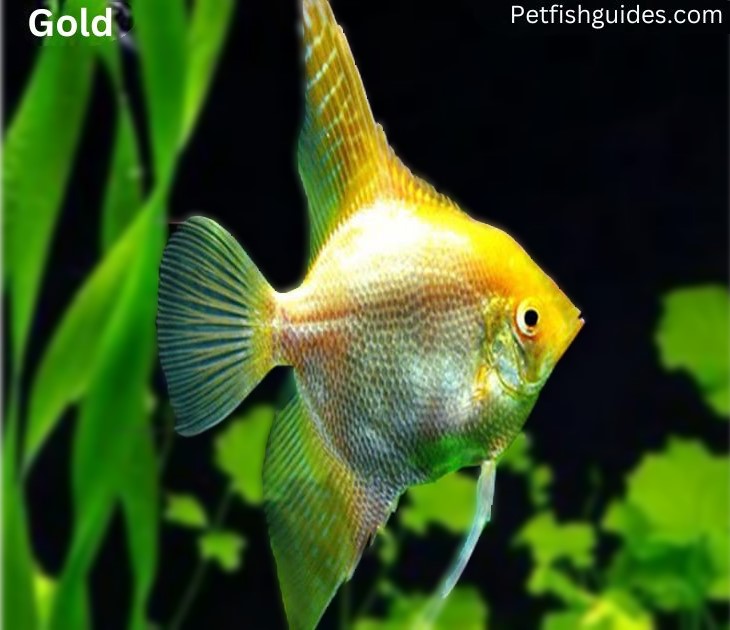
- Species: Pterophyllum scalare.
- Color: Golden body with yellow on top.
- Size: Up to 7 inches long
The gold angelfish variety displays a vivid golden-yellow pigment covering its entire body. Unlike natural black-and-white color schemes, the gold morph lacks any dark vertical barring. Instead, its bright uniform golden tone remains continuous from head to tail.
Selective captive breeding efforts produced this unique gold variety by isolating genetics for yellow color dominance. Breeding programs also developed other shades like platinum white angelfish. But the gold morph’s vibrant and uniform golden yellow palette remains most celebrated for its warm, sunny glow.
The gold angelfish’s ability to retain its namesake radiant hue helped launch its popularity. Its glowing presence and lack of competing darker tones keep it highly desired among keepers.
10. Smokey Angelfish
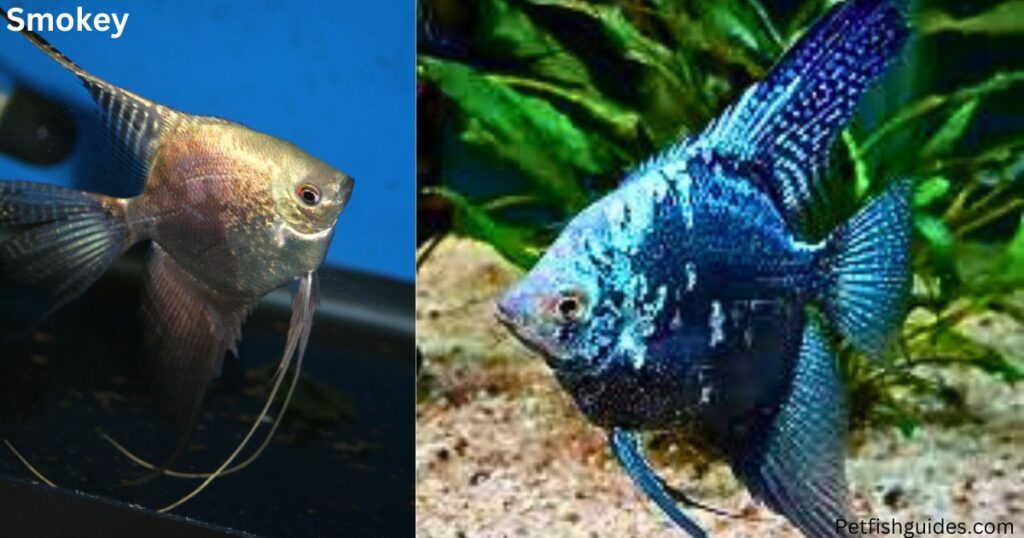
- Species: Pterophyllum scalare.
- Color: Blue / Brown / Grey / Black with an ununiform pattern on the body.
- Size: Up to 6 inches long
Smokey angelfish exhibit an eye-catching dark gray to blackish hue covering their entire body and fins. This dense charcoal pigmentation forms the backdrop for another signature marking – dotted horizontal black lines crossing the body in rows.
The interplay of the deep smokey background and sharply defined black dotted stripes create visual drama. This dark color combo also boldly contrasts against light gravel or decor in home aquariums.
The overall impact gives smokey angelfish great visual presence despite smaller juvenile sizes. Their inky black palette permeated with crisp linear dots proves integral to their aquarium appeal. Even young fish make strong statements. The striking dark tones help novice keepers appreciate smokey angelfish early on.
11. Altum Angelfish
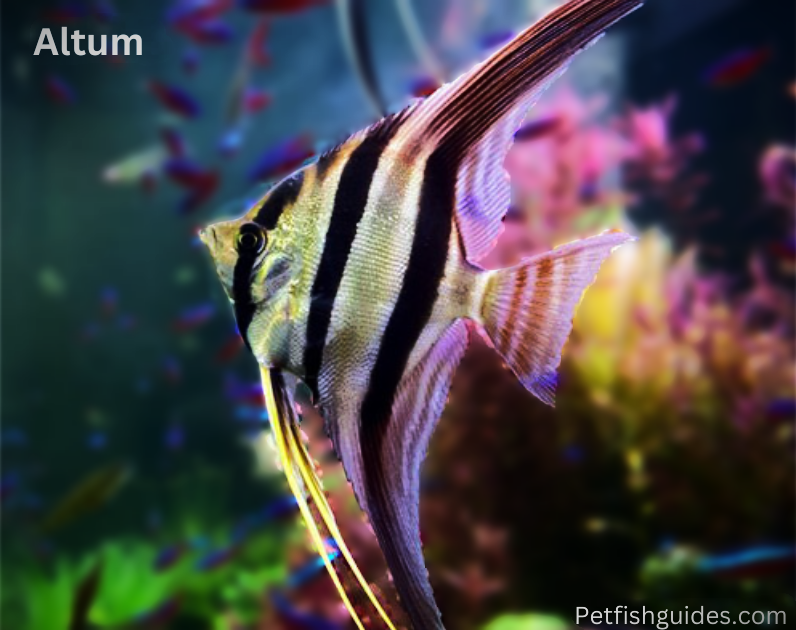
- Species: Pterophyllum altum.
- Color: Gold / Silver / Black
- Size: Up to 7 – 12 inches long
Unlike most common household angelfish, Altum angelfish belongs to the Pterophyllum altum species. They can grow much larger than the P. scalare angelfish varieties, sometimes exceeding 12 inches.
Altums display the familiar barred pattern of three black stripes traversing a silver-white body. But on Altum’s larger canvas, these dark bands appear bolder and more intense. Their more sizable scale also makes them more sensitive to water changes than hardier P. scalare cousins.
So while showcasing similar silver and black color schemes to other angelfish, the Altum’s sheer size amplifies this contrast dramatically. And their advanced height comes with higher care needs. But many view the beauty and aura of these superior giants as worth the challenge for experienced aquarists.
12. Leopard Angelfish
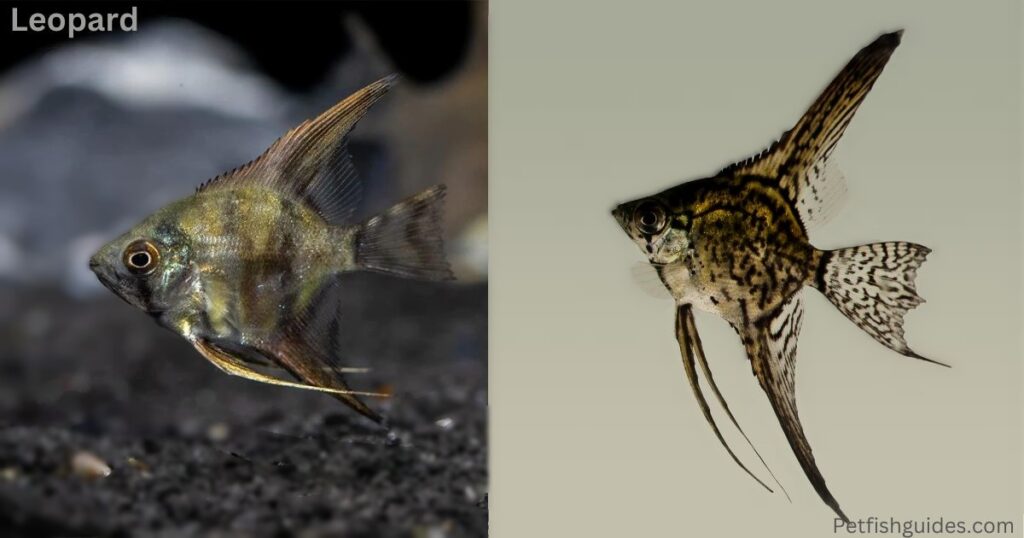
- Species: Pterophyllum Scalare.
- Color: Black / Yellow / Golden.
- Size: Up to 7 inches long
True to their name, leopard angelfish display distinctive black spots scattered across their silver-white bodies, closely resembling leopard markings. The dark round dotting patterns stand out boldly against the paler background shade.
Unlike real leopards though, the spotting appears more prolific towards the rear of the fish. The back half and tail region typically concentrate heavier clusters of inky black rosettes. Meanwhile, the head and frontal areas tend to remain more sparely speckled.
This uneven spot density gradient along the top and bottom body helps create a striking contrast. The bold spotted leopard-like motifs make the variety instantly recognizable. The fitting appearance explains why this color pattern morph came to be called the leopard angelfish.
13. Platinum Angelfish
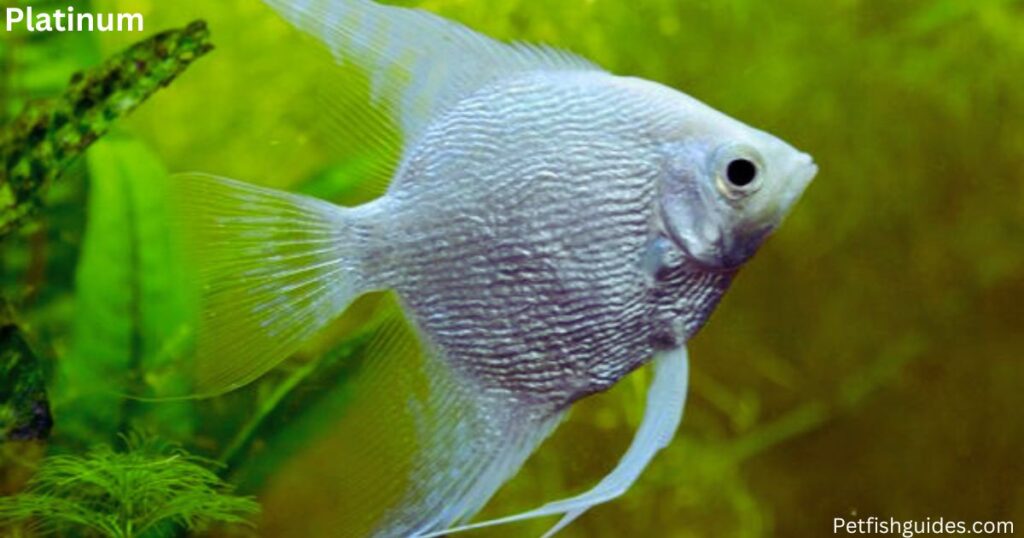
- Species: Pterophyllum Scalare.
- Color: Silver / White.
- Size: Up to 6 inches long
Platinum angelfish embodies an elite status fitting their prestigious name. Their signature feature shows as a clean bright white finish extending from head to tail – a sleek canvas devoid of darker markings. Occasionally a pale yellowish cast may underly the pure white base tone.
Under tank lighting, the stark paper-white pigment appears intensely vivid, even glowing against deeper blue or black gravel or decor. This high light-reflective quality inspired the “platinum” moniker aligning with the precious metal finish.
Yet platinum angelfish requires meticulous care to maintain their namesake luster and avoid yellowing, especially with water quality. When kept in peak condition, their unblemished shining presence rightfully aligns with the elite associations of exclusivity linked to platinum itself.
14. Clown Angelfish
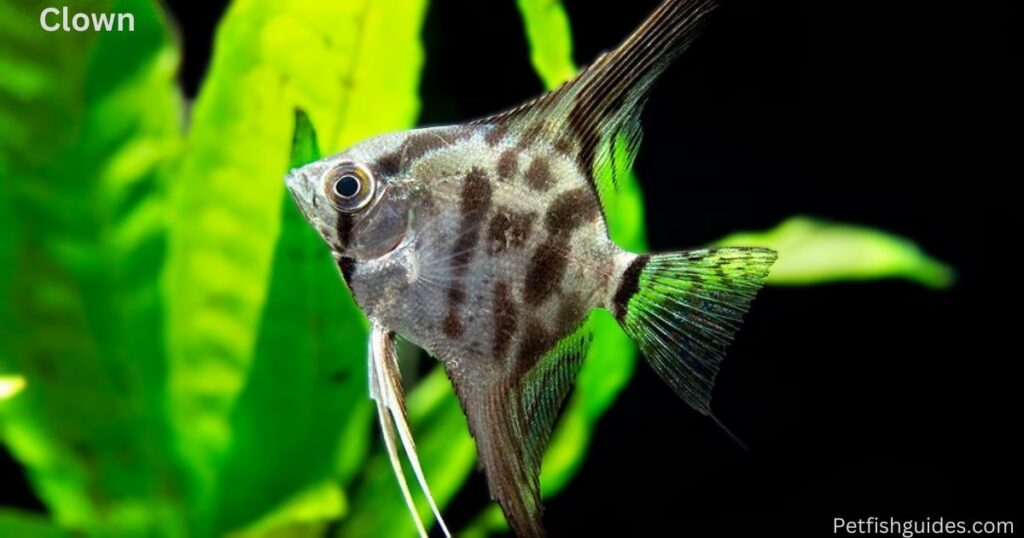
- Species: Pterophyllum Scalare.
- Color: White with a black or orange shape on the body.
- Size: Up to 6 inches long
The name “Clown angelfish” springs from the haphazard black, and sometimes orange, splotches chaotically dotting their entire frame. No two exhibit the same arrangements of messy markings. This randomness closely resembles the scattered motif of clown makeup.
Rather than neat orderly stripes, clown angels’ bodies overflow with crazy unrestrained patterns. The utterly chaotic combinations draw the eye. Their uncontrolled abstract art canvas turns the fish into little performance artists.
Much like clown performers commanding attention in chaotic style, clown angelfish similarly grab the spotlight in aquarium tanks. Their bold messy looks guarantee they remain the focal point among more uniform tankmates. For those seeking fish as captivating as clowns themselves, this angelfish variety fittingly plays the part.
15. Chocolate Angelfish
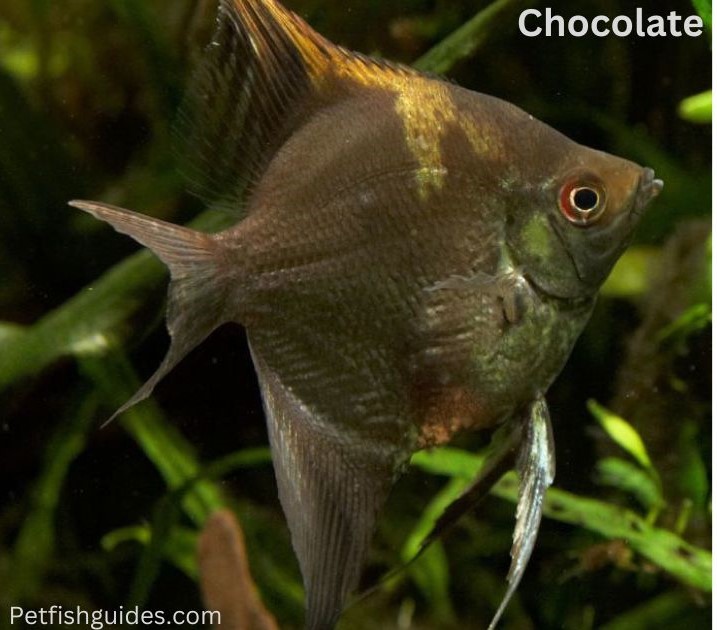
- Species: Pterophyllum Scalare.
- Color: Silver / Brown.
- Size: Up to 6 inches long
Chocolate angelfish displays a decadent, dessert-hued palette featuring deep chocolate brown pigments blanketing the majority of their frame. As the color suggests, rich cocoa tones dominate from tail to torso. But a striking transitional stripe of contrasting silvery sheen often zigzags horizontally across the mid-body before shifting entirely white near the face and gills.
The precise chocolate patterning remains variable per individual based on mood shifts and unique genetics influencing the border contours. Despite variations, one factor stays constant – their indulgent chocolaty shades never fail to tempt the eye, evoking cravings for the gourmet namesake treat itself. Chocolate angels deliver luxurious looks as sumptuous as their moniker implies. Their richness proves equally delicious for home aquarists.
5 Common Types Of Angelfish (Saltwater).
While far more marine angelfish species exist, several standouts have become aquaculture favorites because of their relative hardiness, vibrant colors, and moderate sizes. These include:
1. Queen Angelfish
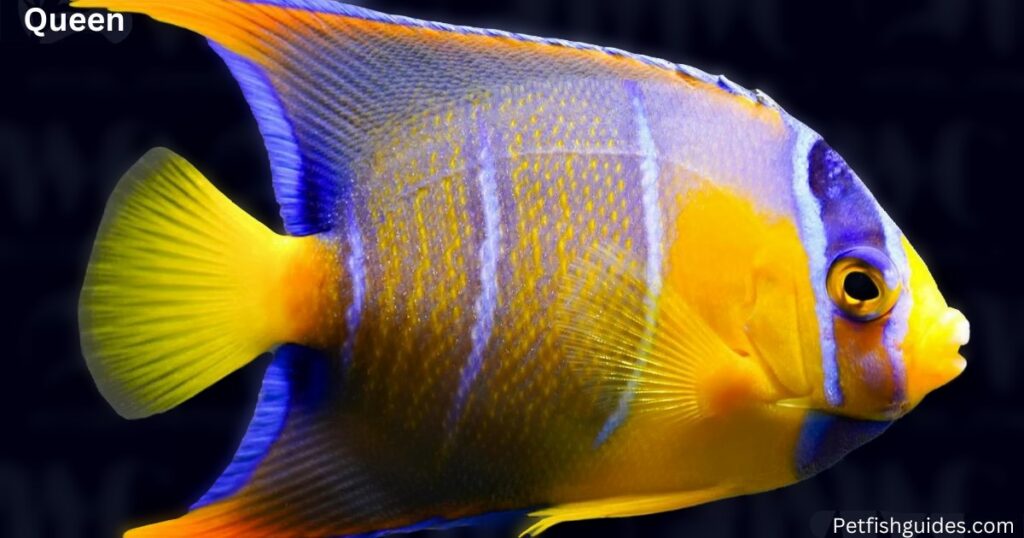
- Species: Holacanthus ciliaris.
- Color: Blue / Orange / Yellow with Crown
- Size: Upto 18-20 Inches
The Queen Angelfish has very colorful and pretty looks. It has an electric blue and bright yellow body that almost seems to glow. There is a dark spot on its forehead surrounded by more blue. And its top and bottom fins are long.
Queen angelfish can grow very big, up to 18 inches long! So they need huge tanks of at least 250 gallons. Make sure to give them lots of places to hide and rocks to munch on. These fish often bully coral reefs and clams by nipping at them. They can also be aggressive to other fish. It’s best to add them last when putting together an aquarium.
Caring for queen angelfish can be tricky. They don’t do well if the water is dirty or their food is low quality. But if you give them the right home, queen angelfish will be the most impressive fish in your tank! Their colors and fins make them true underwater royalty.
2. Emperor Angelfish
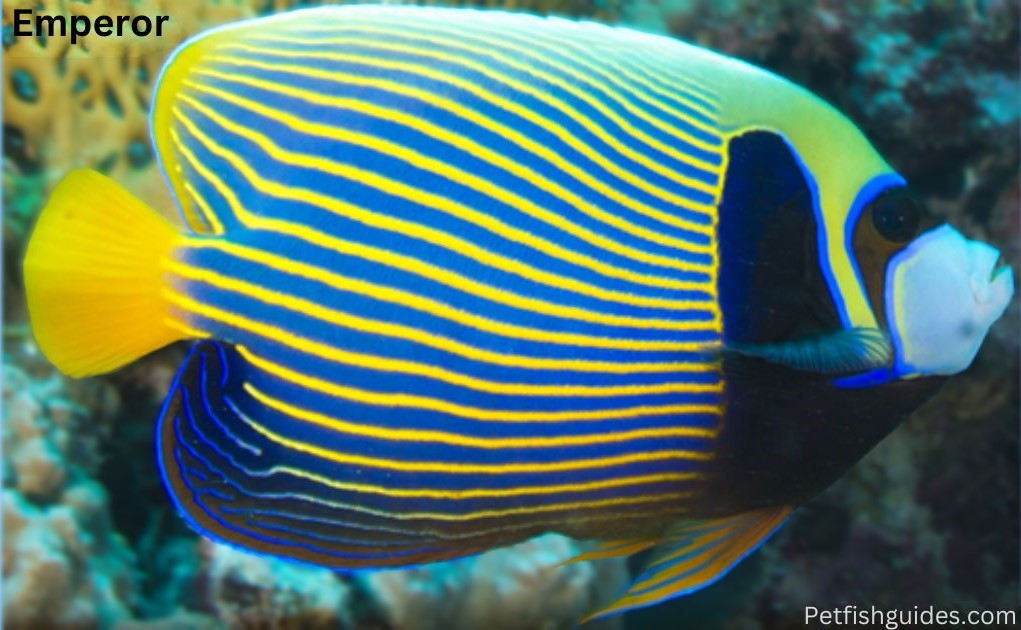
- Species: Pomacanthus imperator.
- Color: Dark blue with white and electric blue Rings / Lines.
- Size: Upto 16 inches.
The adult Emperor Angelfish has a bright blue body with bold yellow stripes running horizontally across it. Its tail fin is a vibrant yellow-orange. A striking blue-black mask covers the eyes, and a similar dark vertical band stretches from its top fin down about two-thirds of its body length. The front of this band has eye-catching sapphire blue highlights, while the back portion contrasts in bright yellow.
Young emperor angelfish looks very different, with circular white and blue stripes starting at the tail on an otherwise black body. As they mature, they slowly transform in coloration and patterns until they reach the adult form. In aquariums, their colors may appear less brilliant, Unfortunately.
These fish need huge tanks of at least 220 gallons packed with plenty of live rock to munch on and deep caves to hide in to feel secure. Although they often nip at coral polyps and clam mantles, emperor angelfish can sometimes live with small, hardy stony corals and soft corals that secrete toxins to deter getting eaten. Their specialized habitat and diet make them one of the more challenging angels to maintain long-term.
3. French Angelfish
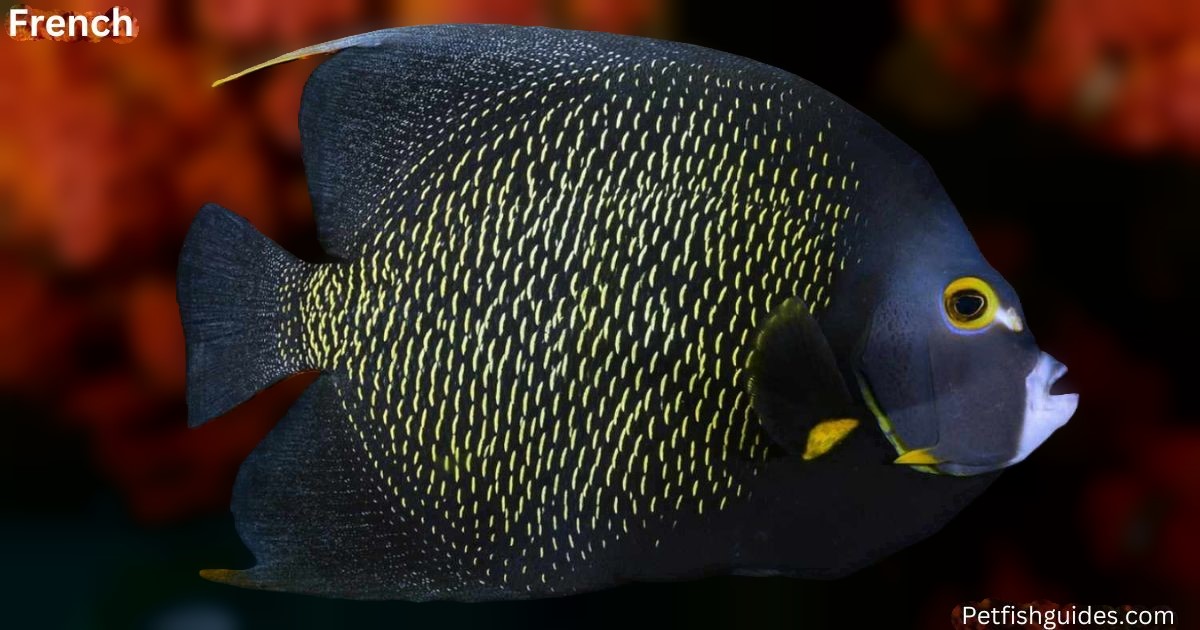
- Species: Pomacanthus paru.
- Color: Black with Yellow Edge.
- Size: Upto 17 Inches.
The French Angelfish is a popular type with a light blue-gray face surrounded by yellow and white. Its body also has a blue-gray color with yellow edges on the scales, giving a speckled look. There is a yellow smudge by the top fin and a yellow border around the gill cover too.
These fish need really big tanks of 250 gallons or more. Make sure to include many rocks for hiding and munching on. French angelfish often bully coral and clams in reef tanks by nipping at them. They can also boss around other fish in the aquarium.
Young French angelfish shows juvenile colors at first. Sub-adults start to transition in appearance. And full adults finally reach the main French angelfish color pattern described initially. The changes happen slowly over time.
4. Flame Angelfish
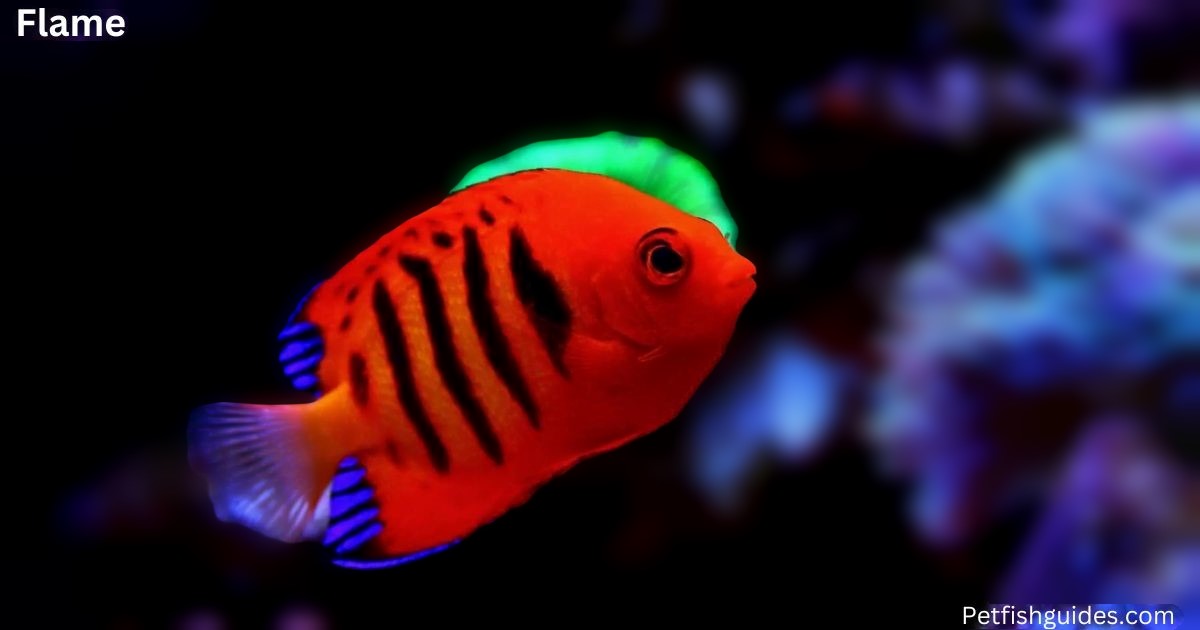
- Species: Centropyge loricula.
- Color: Blod Orange / Red with Black Spot.
- Size: Upto 7 Inches.
The Flame Angelfish has flashy good looks. It is bright red-orange with vertical black stripes on the body. The tail and top/bottom fins also have horizontal black stripes and blue tips. This is one of the most popular small angelfish kept-in-home fish tanks.
These fish need at least a 70-gallon tank with many hiding spots and rocks to nibble. Flame angelfish often bite coral and clams though, so avoid pairing with reefs. They can also bully other fish, so add them last when stocking a community tank.
Flame angelfish do well in established aquariums with fish of different types than them. But watch the copper levels, which they are very sensitive to. The ideal is keeping copper under 0.15 ppm.
An interesting fact about flame angels is that males and females look exactly the same! Breeding them in captivity is extremely difficult too. Their bright colors and smaller size compared to other angels still make them desirable for advanced aquarists.
5. Lemon peel Angelfish
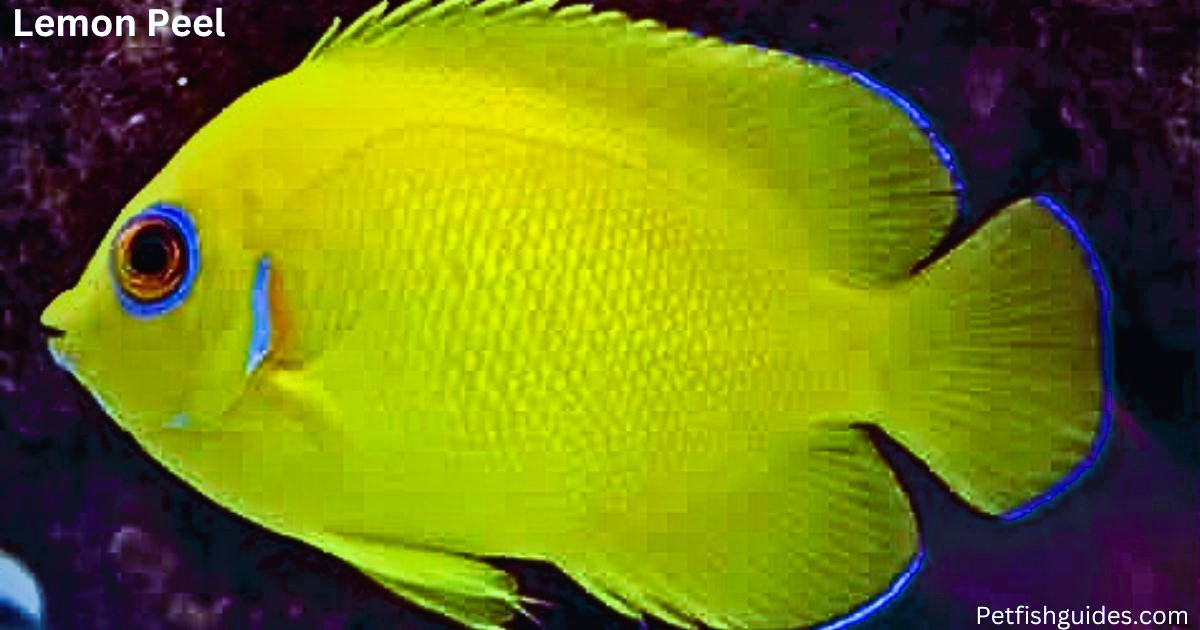
- Species: Centropyge flavissima.
- Color: Yellow with Blue Highlights.
- Size: Upto 5.5 to 6 inches.
The Lemonpeel Angelfish lives up to its cheery name with a bright golden yellow body. Blue highlights color its lips, eyes, top fin, tail fin, and bottom fin for added pop. This angelfish is also called the “True” lemonpeel since a similar one lacks blue tones.
These fish need big 70+ gallon tanks with lots of live rock to nibble on and hiding spots. But lemonpeel angelfish often nip at large polyp stony corals and clam mantles, so avoid pairing them. They also do best housed with fish that aren’t closely related genetically.
The combo of sunny yellow and sky blue markings makes the lemonpeel angelfish very fitting of its citrusy moniker! Its smaller size compared to angels like the queen makes it better suited to home aquariums. Just be sure to meet its specialized care needs for success.
Freshwater VS Saltwater Angelfish
While both freshwater and marine angelfish share wing-like fins and elegant profiles, key differences arise in their genetics, anatomy, tank requirements, and behaviors that are important to consider.
For example, freshwater angelfish inhabit relatively slow-moving, acidic rivers and flooded forests across South America whereas marine species frequent coral reefs. Their bodies have adapted accordingly for their lifestyles over thousands of years. Freshwater varieties also tend towards omnivorous diets whereas most saltwater species strictly only consume meat.
Care factors like pH, salinity, temperature ranges, filtration needs, potential tank mates, and others can vary widely too between the two groups – with marine setups usually demanding stricter water quality parameters overall. Additionally, saltwater species frequently change appearance as they mature. So it’s worth researching your favorites!
That said, both types certainly showcase graceful beauty and appeal when healthy and housed properly. Let’s overview some key care tips next.
Caring For Your Angelfish
While specific care can vary between freshwater and marine species, try following these general guidelines to help your angelfish thrive:
- Perform regular partial water changes to replenish minerals and reduce nitrates. This also removes potential pathogens over time.
- Test water parameters like pH, ammonia, nitrites, nitrates, hardness, etc. and keep them all within the ideal ranges.
- Maintain stable, appropriate temperatures between 75-86°F depending on the variety. Cooler dips can compromise immunity.
- Use efficient filtration like canister filters combined with moderate water movement to guard water quality.
- Feed a varied, high-quality diet like nutritious angelfish pellets supplemented with meaty foods.
- Include soft decor like plants and driftwood to provide comfort and security. Hardy plants also aid with water quality.
- Use dim, blue-shifted LED lighting to prevent stress. Bright white light can wash out colors.
- Quarantine new fish for at least 30 days before adding them to display tanks to prevent disease transmission.
- Research your specific angelfish variety thoroughly – their needs can vary significantly across the many types!
- Following these guidelines tailored to your particular species will help ward off common health issues like intestinal parasites, fungus, bacterial infections, fin damage, nutritional deficiencies, and more!
Read Here: Angelfish Feeding.
Angelfish Compatibility
Angelfish make intriguing additions to moderately sized community tanks thanks to their elegant aesthetics and mostly peaceful behaviors. But compatibility ultimately depends on selecting appropriate tank mates.
For example, long-finned varieties like veil angels may become targets for aggressive nippers like tiger barbs. And smaller fish can become easy prey for peckish angels – especially juveniles under 1.5 inches long!
Instead, focus on schooling species sized over 3 inches with peaceful reputations like certain rasboras, tetras, plecos, cory cats, gourami relatives, dwarf cichlids, danios, rainbowfish, snails like nerites, and particular shrimp-like Amanos. Avoid known aggressive troublemakers too.
Introducing tank mates gradually over weeks instead of all at once also allows angels to establish territory and reduce stress. Carefully researching prospective combinations and observing interactions once housed together is key as well. Have backup tanks ready just in case!
With some strategic planning and vigilance though, angelfish will readily showcase their grace and colors alongside compatible friends. Their interactions can become highlights to observe daily!
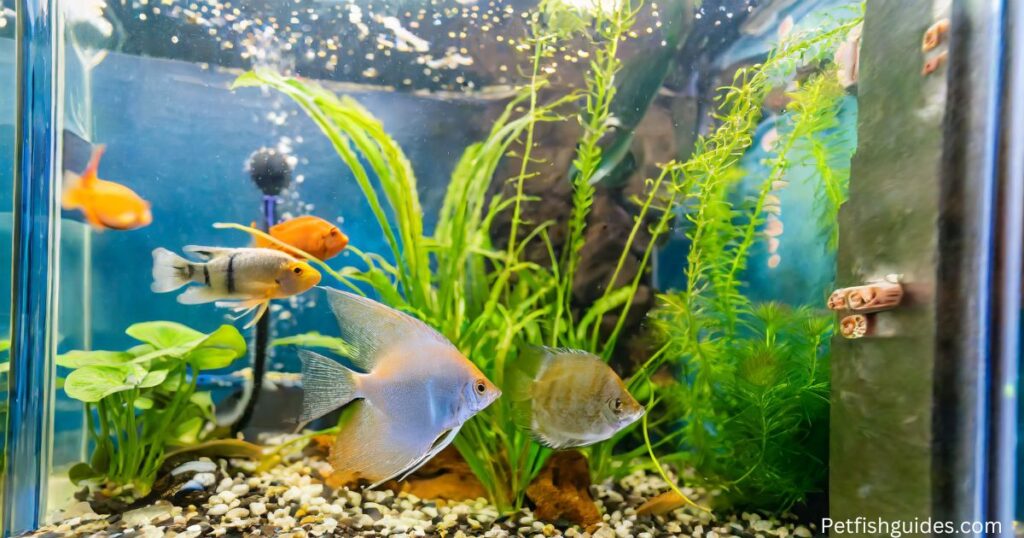
Angelfish Breeding
Many aquarists also enjoy the challenge of responsibly breeding angelfish varieties to sustain genetic lines and supply others with healthy fish. Captive angelfish readily spawn given proper conditions like soft, acidic water between 78-82°F with vertical surfaces present to deposit hundreds of eggs.
Identifying compatible breeding pairs early on helps maximize success rates too – along with conditioning them beforehand with high-quality live foods. Breeding pairs also require their own dedicated tanks with fine-leaved plants or mesh screens to catch falling eggs during spawning embraces. Aquarium salt helps ward off fungus and boosts hatch. The secrets to angelfish breeding align with maintaining ideal water parameters, nutrition, and surfaces to successfully collect fertile eggs through subsequent fry development and growth into maturity.
While more hands-on, breeding allows you to witness the remarkable transformation from egg to free-swimming fry to elegantly winged angelfish firsthand. And sharing your homegrown fish responsibly with others expands the global angelfish community tremendously. So consider giving breeding a try!
Final Words.
Angelfish remains some of the most beautiful and popular fish kept by aquarists. Their fancy flowing fins let them cruise gracefully through both freshwater and saltwater tank displays. Watching angelfish swim elegantly with their wing-shaped fins proves peaceful yet intriguing.
Equally important – angelfish come in an impressive diversity of color varieties and species well-suited for many moderately-sized home aquariums. Between freshwater angels and marine variants, keepers can find an angelfish to match their setup.
Whether coasting through vivid reef landscapes or gliding among vividly planted tanks, angelfish never fail to dazzle viewers. The combination of their smart behaviors, fancy appearance, diversity, and moderate care requirements secure their rank among the most coveted aquatic fish to keep.

